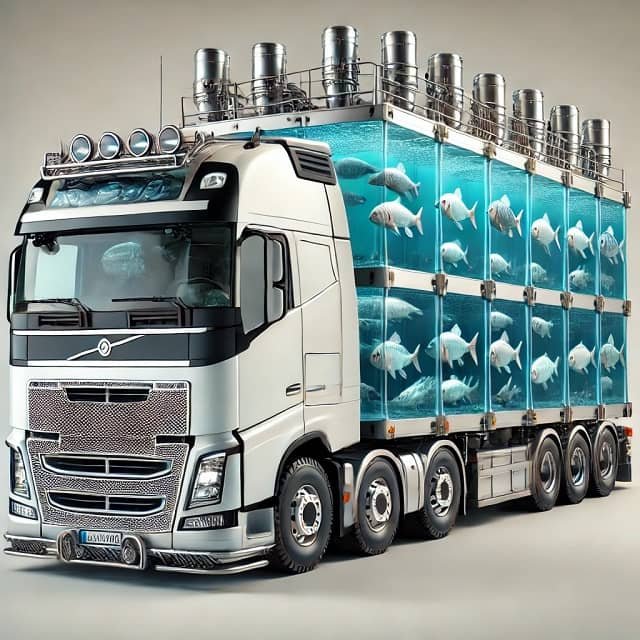Farmed ballan wrasse fed extruded feed over long periods when young develop skeletal deformities. Therefore, scientists believe that feed of right technical quality is very important for fish welfare.
Ballan wrasse is a fish species used in salmon farming to remove sea lice. To reduce the use of wild-caught ballan wrasse as cleaner fish in salmon cage farming, ballan wrasse are now being farmed and released into net pens together with the salmon. As part of the farming process, ballan wrasse are hatched and then fed with live feed for a period. The fish are then weaned to artificial diets and on-grown until released into the salmon net pens. Even though farmed ballan wrasse are fed highly nutritious diets, they are growing slowly and develop significant skeletal deformities. Following several trials were scientists attempted several approaches to improve nutritional status and survival rates in cleaner fish, it turned out that feed technology was one of the key factors to achieve good fish health:
“We have now shown that technical feed quality is very important for fish welfare”, says Katerina Kousoulaki, feed scientist at Nofima.
Why?
Ballan wrasse has a very simple digestive system, lacking both stomach and pyloric caeca. Feeds that are processed differently affect digestion in ballan wrasse in a different way too.
“In the first trial, ballan wrasse larvae that were weaned onto dry feeds had a good appetite for the hard, extruded feed, and we saw good survival rates. After a few weeks, however, the fish started to develop skeletal deformities. Fish that were fed a soft, agglomerated diets, a type of feed that is processed at low temperatures, appeared to have far lower deformity rates”, says Kousoulaki.
Following, the scientists decided to make a single feed mixture, half of which was extruded, and the other half agglomerated. The feed was then tested in weaning ballan wrasse larvae. The results showed that after a month, extruded feed resulted in 41 % fish with skeletal deformities, whereas almost no deformities were seen in the fish that received the agglomerated feed (under 2 %). The body analyses of the ballan wrasse showed that those fed the extruded feed had barely taken up minerals from the feed, while fish fed the agglomerated feed showed good mineral status. The deformity rates correlated with the amount of phosphorus analysed in the body.
Stay Always Informed
Join our communities to instantly receive the most important news, reports, and analysis from the aquaculture industry.
It was also shown that poultry meal in the feed may counterbalance some of the disadvantages of conventional extrusion. Cold-extrusion also resulted in higher mineral uptake compared to conventional extrusion, which takes place at high temperatures.
The scientists have developed a theory that high extrusion temperatures make feed minerals difficult to access for a fish species like ballan wrasse, which has no stomach or acid digestion. Ballan wrasse are also rather fussy when it comes to their diet. They like shrimps or krill and prefer little or no fish meal in their feed. Instead of fish meal, cod fillet meal is used that hardly smells of fish but attributes to increased pellet hardness.
Senior scientist and fish welfare scientist at Nofima Ingrid Lein is the project manager of CleanFeed project. She believes that reducing the extent of deformities is essential for the welfare of the fish, and feed processing can play a role.
“What is clear from the trials is that conventional high temperature extrusion, which is normal for salmon feed, does not work for this fish species. However, there continues to be a lot of deformities in ballan wrasse despite the fact that feed companies are taking action, so I think that the problem is more complex”, says Lein.
In the scientific publication, the main conclusions are summarised as follows:
– Hard, commonly extruded feed pellets used to wean ballan wrasse larvae resulted in skeletal deformities
– Softer, agglomerated feed particles resulted in higher mineral uptake in ballan wrasse larvae
– Extruded feeds resulted in higher fat levels in the liver and higher mortality rates in ballan wrasse juveniles
About the research
The main project CleanFeed is funded by the Norwegian Seafood Research Fund (FHF).
The first dry feed habituation trial on ballan wrasse was conducted in 2017, funded by Nofima and MOWI. Analyses and follow-up trials have been organised by CleanFeed.
Scientists from Nofima, the Norwegian University of Life Sciences, the Institute of Marine Research and the fish farming company called MOWI have contributed
Trial feed from Nofima and commercial feed.
Contact person
Aikaterina Kousoulaki
Senior Scientist
Phone: +47 479 10 710
katerina.kousoulaki@nofima.no
Ingrid Lein
Senior Scientist
Phone: +47 934 19 441
ingrid.lein@nofima.no
Reference (open access):
K. Kousoulaki, E. Grøtan, T.M. Kortner, G.M. Berge, G. Haustveit, Å. Krogdahl, H. Nygaard, Ø. Sæle, E.M. Chikwati, I. Lein. Technical feed quality influences health, digestion patterns, body mineralization and bone development in farming of the stomachless cleaner fish ballan wrasse (Labrus bergylta). Animal Feed Science and Technology, Volume 274, 2021, 114830, ISSN 0377-8401, https://doi.org/10.1016/j.anifeedsci.2021.114830.
Source: NOFIMA
Editor at the digital magazine AquaHoy. He holds a degree in Aquaculture Biology from the National University of Santa (UNS) and a Master’s degree in Science and Innovation Management from the Polytechnic University of Valencia, with postgraduate diplomas in Business Innovation and Innovation Management. He possesses extensive experience in the aquaculture and fisheries sector, having led the Fisheries Innovation Unit of the National Program for Innovation in Fisheries and Aquaculture (PNIPA). He has served as a senior consultant in technology watch, an innovation project formulator and advisor, and a lecturer at UNS. He is a member of the Peruvian College of Biologists and was recognized by the World Aquaculture Society (WAS) in 2016 for his contribution to aquaculture.




